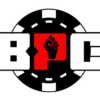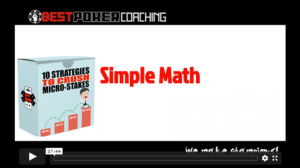Approaching the bubble in MTTs is the most important stage of the tournament. If you can survive the bubble, you break into the first places paid and guarantee yourself a payday. To play this stage profitably, there are a number of semi-advanced concepts that you’ll need to be aware of. Learning these concepts will allow you to punish the many weak players who consistently underplay the bubble. Get ready to boost your tournament ROI with the following tips.
INDEPENDENT CHIP MODEL (ICM)
In part 6 of mastering MTTs, I introduced you to the Independent Chip Model (ICM). This is a very important and extremely useful concept when approaching the bubble. ICM changes the emphasis on decision making from chip equity (cEV) to tournament equity ($EV). Here’s how it works.
In cash games, you make a ton of decisions based on pot equity calculations using the standard chip equity function. For example, you can determine the profitability of a bet by comparing your opponent’s range to your equity in the pot. If your equity is higher, then a bet is profitable as long as your ranging skills are accurate enough. Unfortunately, it doesn’t work this way in tournaments because of the principle of diminishing chip value.
In tournaments, the value of each chip decreases as the game goes on. The best way to explain this is through prize pool distribution. Say you buy-in to a $50, 180-man MTT with 3,000 starting chips. In this example, the value of each chip is roughly $0.17 (buy-in / starting chips) at the beginning of the tournament. If we win the tournament (after several hours of play), we end up with all 540,000 chips and a prize of $3,000 which would diminish the value of each chip to $0.005 (yes, half of a penny). This significant decline from start to finish proves that chip value steadily decreases as the tournament progresses.
What this means is that a +EV decision in a cash game won’t always be a +EV decision in a tournament. It also means that the chips you stand to win are not always worth the chips you put at risk to win them. It’s a higher risk for a lower reward resulting in marginally profitable decisions often become losing decisions. Sometimes risking chips is unnecessary, even when you have a strong hand and especially during the bubble.
For example, there are 27 places paid in a 180-man MTT and there are 28 players left. We’re in the cutoff with JJ and face a shove from a MP player who has us covered. But we notice the player on the button has only 5bb left and is likely to bust out very soon. Calling here is usually going to be a positive expectation in terms of chip equity (+cEV). However, risking our entire stack is unnecessary when the short stack will inevitably bust. Going out one place from the money before and letting the short stack sneak past the bubble would be an absolute disaster.
DETERMINING TOURNAMENT EQUITY
Let’s learn the math behind calculating chip value. Again, tournament chip equity is the actual monetary value of each chip with regards to the prize pool distribution and all player’s chip stacks. Nothing else matters. Not player skill, not the blinds, nothing.
Take the following example from a $10 SNG with 3 players left at the final table. Each player started with 1,500 chips.
- Player A has 7,500 chips.
- Player B has 5,000 chips.
- Player C has 2,500 chips.
The prize pool distribution is $50, $30 and $20. To calcuate the actual monetary value of the chips in play, we need to use an equity calculator from HoldemResources or ICMIZER. Here are the results:
- Player A (7,500) has $38.50 in tournament equity.
- Player B (5,000) has $34.00 in tournament equity.
- Player C (2,500) has $27.50 in tournament equity.
Remember, the risk of losing chips is greater than the reward of acquiring them due to diminishing chip value. This means we should be playing very tight as we approach the bubble because of the negative expectation of calling an effective all-in. Unless the odds our greatly superior, say 2 to 1 (or 67%), the risk will often outweigh the reward. If you’re only a marginal favorite, tournament equity (and not chip equity) means it’s likely an unprofitable call for your tournament life.
A chip stack of around 30BB or more is optimal as your approach the bubble. This will allow you to play a tight-aggressive style with enough wiggle room to take advantage of profitable situations such as stealing the blinds or value shoving vs weak opens. You’ll still want to avoid big confrontations with any deep stack players if at all possible. If you’re short stacked (less than 10BB) during this stage, you will generally be limited to a push/fold strategy.
SUMMARY
Making the correct decision, whether it’s a call, shove or fold, should be based on the monetary profitability ($EV) in regards to the ICM concepts mentioned thus far. By factoring in the expected value of $EV, we can make more profitable decisions based on the risks/rewards of tournament equity. In simple terms, if the risk of acquiring chips is too high, our expected tournament equity will diminish. However, if risks are small enough, then the profitability to call or shove yourself greatly increases. I highly recommend taking advantage of tools such as ICMIZER, HoldemResources and SNGWizard to help you understand and implement this very important concept.
By now, you should a basic understanding of ICM and some general strategy to get you through the tournament bubble. In the next lesson, you will learn about the late stages of an MTT and how to start building your stack for a run at the final table.



